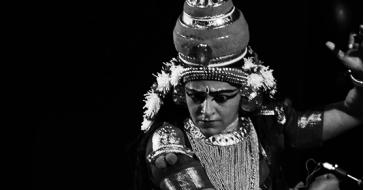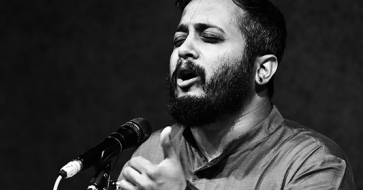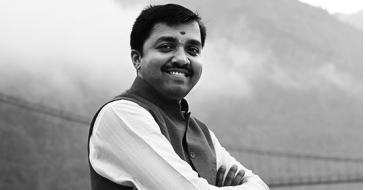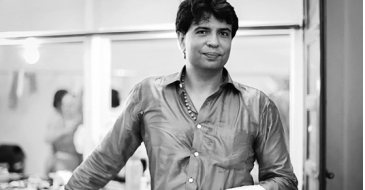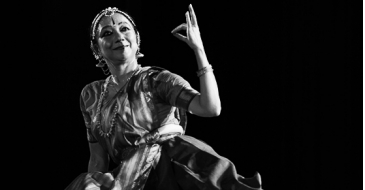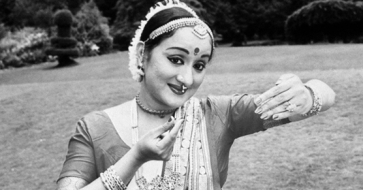How old were you when you began to learn the margam?
I started to learn Bharatanatyam when I was three! My parents were extremely busy doctors and we lived on Poonamallee High Road, Kilpauk, above our hospital. It was a life surrounded by newborns being delivered, midnight emergencies, long outpatient queues, expectant mothers and wailing babies. Despite their hectic lives, my father Dr B Rangarajan was a huge Carnatic music aficionado and somehow his talent of identifying a raga came to me naturally, even at that young age. My mother, Dr Vasanthi, had actually learnt Bharatanatyam from Pandanallur Sri Chockalingam Pillai and had stopped when she joined the medical world. My grandmother, Smt Janaki was equally interested in the arts but more importantly was very emphatic that I should be taught music and dance and was a very determined grandma indeed, intent on my success! I was taken to watch many a dance performance and on seeing me trying to repeat what I had witnessed with such childish abandon, I was taken to family friend, Smt Kamala Laxman, who, having started her lessons in Bharatanatyam early on herself, was all for starting my classes right away.
I, however actually did not learn the margam even after the adavus were completed. Instead I played little Bharata, Krishna and Sita in many of my guru’s dance dramas and learnt the margam only at the time of my arangetram in 1977, when I was seven years old!
Do you recall your earliest full-length performance of it? Capture that moment for us?
My first margam was for my arangetram in 1977. Those days, and even well into the 80s, performances were always for two-and-a-half hours at least or more so, and it always featured the full margam being performed. My arangetram had an Alarippu, the Subramanya Kavuthvam, the Jatiswaram in Kalyani raga that was later remade in the same metre but in Malayamarutham raga by Smt S Rajeswari. This was followed by the very unique Mandooka Sabdam, that had syllables mimicking a frog’s sounds, then followed by the varnam, Sadinchene. I also performed a couple of kirtanas after the varnam, followed the Dhanashree thillana and concluded with Andal’s Varanamayiram. I remember the endless rehearsals that I had, and the days spent in realising the strenuousness of the varnam for the first time. I remember that even today, because I also later came to realise that constant practice made it less strenuous and one learnt to breathe easy and dance with tranquillity. But without practice, the margam could well end up being an exercise in testing endurance and causing physical pain, torturing both the dancer and the audience!
Bharatanatyam is a subtle art form. There is room to portray many ideas but auchitya or propriety is key
Over the years, has your relationship with the margan evolved?
It so happened that by the time I was nine years old, my guru had suddenly vanished to the USA with no promise of return, and as my family felt that my dance talent needed to be nurtured, I was enrolled into Vazhuvoor Sri Ramaiah Pillai’s school and learnt another margam from Vazhuvoor Sri Samraj. By then, I was a pre-teen and for the first time I had learnt a proper padavarnam, Naathanai Azhaithu Va Sakiye. Now, the jatis were bigger and harder but the magic of Sri Samraj’s nattuvangam enthralled me so much that I breezed through it all. I learnt another lesson — dance becomes magic with the right musical accompaniments and nattuvangam; from making it feel like arduous hard work, it can make you soar as light as a bird!
And then I finally settled down to learn from Swamimalai Sri S K Rajarathnam Pillai, who I consider my actual guru who honed my talent completely. And he was an accomplished singer as well, so I learnt to enjoy the magic of the margam through my guru’s wonderful precise choreography and divine singing. Here, I learnt the art of dancing the margam in its complete form, including padams, javalis, and the traditional varnams and thillanas of the Tanjore Quartet. Here, I had learnt the proper margam at last!
As a dancer-choreographer, do you find the margam limiting or liberating?
After my guru’s demise in the 90s, I have been presenting my own choreographies.
Being a solo artiste, I somehow feel that the margam format is what best suits me rather than any other structure. I have so far, not been restricted by the margam; in fact, I have been able to use it for more and more non-religious and non-traditional ideas as well! I think that that is the power of the margam.
An old Tamil padam shines radiantly, but so does a newly composed song on working mothers and their children — both these are two very different subjects, yet they can take the place of the traditional padam. I have been able to dance about Ayodhya and Babri Masjid, the degradation of the Cooum, the frightening Uttarakhand floods and so many more, all fit into the margam grid. I have also been able to add my own embellishments to varnams – such as inserting Swati Tirunal padams to Sumasayaka, adding Prabandham poems to Sakiye, to name a few. And so, I do not think that the margam is limiting. But, I also do think that today, there is much emphasis on the varnam with its long sancharis and jathis, that the rest of the margam often takes a backseat.
This season I have included the jatiswaram as the first piece as I don’t have the time to perform the traditional pushpanjali as well as the jatiswaram. I wish we could do the full margam and agree to limit the varnam’s length, say to a maximum of 20-25 minutes. But, today, unfortunately, long jathis and long applauses after each jathi are seen as a hallmark of excellence.
Hailed a child prodigy, you have performed traditional margams from a very young age. What does a margam mean to a young child and what is the kind of a perspective through which it unfolds through the eyes of a mature adult?
As I said before, I never did do a traditional margam based on the sringara rasa at my arangetram. To me, the varnam appeared long and strenuous. I had learnt two pieces as varnams — Sadinchene and the Dasavatara varnam. I did enjoy the post varnam pieces much more, as they had stories to narrate and many were about the exploits of Lord Krishna as a child that I identified with as a young kid! I never thought about the margam or had even heard of the term then! It was only during my years with Rajarathnam Sir that the beauty of the masterpieces of the margam unfolded. I got to know the grandeur of the Kamas, Useni, Kalyani and varnams in other such majestic ragas, the correct kalapramanam, the holding of the sthayi bhava through the two kalai chavukkam pallavi and anupallavi of these varnams and the way to sustain perfection of form and stamina throughout.
When did you first realise you could actually innovate within the margam?
My first foray into innovation within the margam was for the Kalamandir Trust. Sri Viswanathan was a wonderful patron of the arts and particularly encouraged young artistes. In 1991, he conceptualised a festival, Devata Vandanam, where he wanted each of us to present a margam on a particular deity and he did not want it to be just a compilation of random pieces but a well thought out flow. I was to dance and present pieces on Lord Muruga and my guru let me think out the whole margam, where I visualised pieces that addressed Muruga as God, child, lover, warrior and as the principal deity of many Tamilians. It was very interesting to pick out appropriate verses, songs and lyrics and I enjoyed creating the margam even more than performing it! This was titled Bhavaye Karthikeyam.
I, then created a margam presentation titled Prabodhana – An Awakening, which had the Vaishnavite saint Andal‘s poems woven into a margam. The varnam was most interesting and I sought the help of Sri B Seetharama Sarma to weave a few verses of the Thiruppavai into a varnam format with swaras also. At this time, I also remember a very young TM Krishna sitting on the swing with his guru Sri Seetharama Sarma and writing the notations down for him!

In your production, Chennai, you brought forth the essence of this city in a margam; and in Kavya Tamizh, you performed to a collection of Tamil poems. What is the personal connect you have with each of these themes? Can you explain in detail?
I have been an avid student of Tamil all through school and my family has always been quite anchored to the ideology, that as Tamilians we should learn and value Tamil above all else.
As it happened, I married into a family that shared this view completely. My father-in-law is a great rasika of Tamil poetry and literature and also is a patron of various organisations that foster Tamil literature. My mother-in-law is equally fond of Tamil literature and her mother Smt Soundra Kailasam was a great Tamil poet herself.
Kaviya Tamizh was created using Tamil poetry of various eras, stitched into a margam and for the first time I choreographed a poem by noted Tamil lyricist, Vairamuthu, which I first heard as it was being recited by my father-in-law, who had read this very beautiful poem on Yashodhara from the compilation, during a book release function. I then ventured out to create another margam, Vainava Tamizh, using poetry from the Divya Prabandham, to create a margam template and here, I took the advice of late author Sri Sujatha on choosing poetry of various moods and emotions and with the right metre to enable musicality.
Chennai was something I created for myself. I suddenly felt one day that we were always dancing in praise of cities like Thanjavur, Tiruvarur or Varanasi. Why not dance about the city that I was born in, lived all my life and love deeply despite all its warts? I did not want to dance in praise of the city’s temples or its deities; instead, I chose a wide range of themes for the margam starting with a specially composed poem by Sri Vairamuthu that perfectly captured the emotion that I felt towards my city,
‘Chennai manne vanakkam
Engal annai manne vanakkam
Deham oru naal theerndhu poyinum
Jeevan ingu dhan irukkum’
Mylapore was the focal point for the varnam and utilising Carnatic musician, Smt Aruna Sairam’s guidance, we made a medley of all the popular Papanasam Sivan kritis on the Mylapore Kapaleeshwarar temple and wove it into a varnam. There were songs on modern working mothers of Chennai, a nostalgic trip to Georgetown with a javali, a piece on the gradual destruction of the Cooum river and Bharatiar’s poems sung at the Marina. Sri PC Ramakrishna was the narrator and this was one margam that consumed me totally!
In all these new endeavours, I have to mention how invaluable Swamimalai Sri Suresh was and still is. He is a well-known genius when it comes to composing music for dance and I am truly blessed that he was able to work with me on these unique themes. Smt Radha Badri was able to translate all these compositions into divine melody and with bhava laden renderings that added to the calibre of the margam.
My advice to students of dance would be to observe, but never imitate blindly. The guru is the right person to guide a student on what is right and what looks appropriate
Is there space for contemporary ideas and subjects in a traditional margam?
Of course there is. But the one thing to remember always is that, Bharatanatyam is a subtle art form. There is room to portray many ideas but auchitya or propriety is key. And I think that, one can still convey a host of new thoughts and ideas through the traditional margam, despite the need for subtlety.
In a margam itself, aside from the nayika waiting for her Lord, we see many more new themes being performed. What is your take on this? Do you think your innovation began stemming from the need to move beyond this? As a dancer do you find it easy to relate to content of the past?
No, I did not start innovating on the margam because I found the traditional content stifling. The Bharatanatyam margam has so much traditional content that one can never hope to exhaust it all. The theme may be sringara, but the layers and layers of moods and variations are truly staggering and performing these timeless creations has a certain magic in itself. In fact, what is rather wearisome to watch these day,s is actually the types of choreography with interminable stories enacted from mythology in great detail and huge marathon jathis that bloat the item so much, that it really becomes a bit too boring to watch. I don’t think that in the past this was the norm. Multiple ideas and thoughts were conveyed quickly and effectively.
In a bani, do you feel that the technique alters as it is passed on from generation to generation, dancer to dancer?
My guru was from the Vazhuvoor bani but he made alterations both in adavu execution and the content in the sense that he emphasised more on geometry and a tad stiffer stance, in comparison to the other Vazhuvoor bani adavus, which were also precise but a bit more sinuous. He also started composing a lot of varnams from the Tanjore Quartet, and thus somewhat blurred the bani boundaries.
I think today banis have blurred a lot more and we all would love to really take the best from any bani, which I feel, is not a bad thing. Also with so much of exposure through the internet and through dance workshops, students tend to absorb all sorts of influences. My advice to them would be to observe but never imitate blindly. The guru is the right person to guide a student on what is right and what looks appropriate.
How do you manage to stay relevant in a time when short, crisp pieces with contemporary subjects are appreciated rather than a composition, say by the Tanjore Quartet?
I think all senior artistes in Bharatanatyam perform margams and especially long varnams.
We have to stay relevant by making sure that every piece we perform is well thought out, is crafted with interesting elaborations and is out-of-the-box, with every nritta passage well practiced and polished. The audience can sense and appreciate artistic integrity very accurately. They can also spot fake and pseudo dancing very well. While designing a performance, it is nice to have a mix of the old with some contemporary ideas so that a performance has something for everyone to enjoy.
I have so far, never felt restricted by the margam. Rather, I have been able to incorporate non-traditional and non-religious ideas as well — that is the power of the margam
This year, your performances are called Vintage; could you talk about it?
Though I have been experimenting on the margam, I felt an urge this year to stop and go back to a completely old-world, evergreen set of pieces from the traditional Bharatanatyam repertoire. Much like living in salwar kameez and trousers but one suddenly pulls out a heirloom Kanjivaram saree and enjoys wearing that as well. Sometimes we need to revisit that charming bygone era of Bharatantyam but of course, I have added my own interpretations! You will find me performing a jatiswaram, the majestic Kamas padavarnam of the Quartet, two abhinaya pieces that are absolutely light and frothy and an old thillana as well.
Does Bharatanatyam, in its traditional, pure form have a place in the future, or should dancers ‘innovate’? You have addressed these ideas also in your conference. Why do you think this is an important subject of conversation?
I think there are several aspects to this — technique and form is paramount and I think we should work always towards smooth perfection and grace in every stance and glance and believe me, this needs a lot of hard work every single day, all the more so as we age.
Innovation and creativity are of course, very important but the basic framework needs to be intact and perfect.
One can also look at the whole thing from the audiences’ viewpoint — it must be something that attracts audiences which is a key challenge for dance today. Maybe audiences need more spontaneity, more manodharma and maybe the varnam needs to be shorter with more crisp pieces. We find group programmes, especially lavishly mounted dance dramas being extremely popular. The solo performance experience perhaps needs to be revitalised, and by that I also mean the performance space, lighting and the acoustics, so that it is a complete experience for the viewer.
Interviewed by Sankriti Krishnan
0 comments Comments





